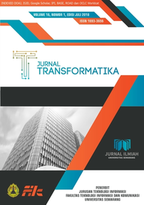Fuzzy Tsukamoto Implementation on Internet of Things to Control Flooding
DOI:
https://doi.org/10.26623/transformatika.v17i2.1700Keywords:
Floods, Fuzzy Tsukamoto, Internet of ThingsAbstract
A Flooding is a disaster that often occurs in the Semarang area, especially on Jl. Raya Kaligawe. Flooding can occur due to the ineffectiveness of the pump work in a water impregnation pool. The impact of the floods is detrimental to students because with the flooding it can interfere with teaching and learning activities and studying student activities when on campus. At Sultan Agung Islamic University, Semarang has a water impregnation pool that is still manually controlled. By using Fuzzy Tsukamoto as artificial intelligence on Internet of Things technology, we can carry out intelligent control systems in water absorption pool pumps in realtime, so as to prevent and reduce human error that causes flooding. In principle, the Internet of Things works using a microcontroller, one of the microcontrollers that can be used, namely Wemos D1 mini. Wemos D1 mini is connected with an ultrasonic sensor to measure water level in a water infiltration pond, air temperature and air humidity sensor to detect rain.
References
Ariyani D and Putri R. Sistem Monitoring Banjir Pada Jalan Menggunakan Aplikasi Mobile Dan Modul Wi-Fi. Prosiding SEMNASTEK Fakultas Teknik Universitas Muhammadiyah Jakarta, Jakarta. 2017. Vol.4: 1 8.
Rosyidie A. Banjir: Fakta dan Dampaknya, Serta Penngaruh dari Perubahan Guna Lahan. Journal of Regional and City Planning. 2013; 24(3): 241 249.
Ekajaya F, Hidayat N, and Ananta M. Diagnosis Penyakit THT Menggunakan Metode Fuzzy Tsukamoto Berbasis Android. Jurnal Pengembagan Teknologi Informasi dan Komunikasi Ilmu Komputer. 2018; 2(8): 2361 2365.
Loong K, Sandeep S, and Tschofenig H. Securing the Internet of Things: A Standardization Perspective. IEEE Internet Things Journal. 2014; 1(3): 265 275.
Junaidi A. Internet of Things, Sejarah, Teknologi, Dan Penerapannya : Review. Jurnal Ilmiah Teknologi Infromasi Terapan. 2015; 1(3): 62 66.
Kulkarni G, Gambhir J, and Palwe R, Cloud Computing-Software as Service. Int. J. Cloud Comput. Serv. Sci. 2012; 1(1):11 16.
Syafitri N. Simulasi Sistem Untuk Pengontrolan Conditioner Dengan Menggunakan Logika Fuzzy. Jurnal Informatika. 2016; 10(1): 1164 1172.
Kusumadewi S. Arficial Intelligence (Teknik dan Aplikasinya). Pertama. Yogyakarta: GRAHA ILMU. 2003.
Nazilus M, Alfita R, and Nahari R. Prototype Sistem Monitoring Dan Pengendalian Pintu Air Otomatis Sebagai Peringatan Dini Bahaya Banjir Berbasis Internet Of Things. Seminar Nasional Matematika dan Aplikasinya Universitas Airlangga. Surabaya. 2017: 377-385
Meilina P, Rosanti N, and Nuraeni A. Sistem Pendukung Keputusan Penentuan Jumlah Produksi Barang Dengan Metode Fuzzy Tsukamoto Berbasis Android. Prosiding SEMNASTEK Fakultas Teknik Universitas Muhammadiyah Jakarta, Jakarta. 2017. Vol.4: 1 8.
Downloads
Published
Issue
Section
License
Authors who publish with this journal agree to the following terms:
- Authors retain copyright and grant the journal right of first publication with the work simultaneously licensed under a Creative Commons Attribution License that allows others to share the work with an acknowledgement of the work's authorship and initial publication in this journal.
- Authors are able to enter into separate, additional contractual arrangements for the non-exclusive distribution of the journal's published version of the work (e.g., post it to an institutional repository or publish it in a book), with an acknowledgement of its initial publication in this journal.
- Authors are permitted and encouraged to post their work online (e.g., in institutional repositories or on their website) prior to and during the submission process, as it can lead to productive exchanges, as well as earlier and greater citation of published work.

Transformatika is licensed under a Creative Commons Attribution 4.0 International License.

